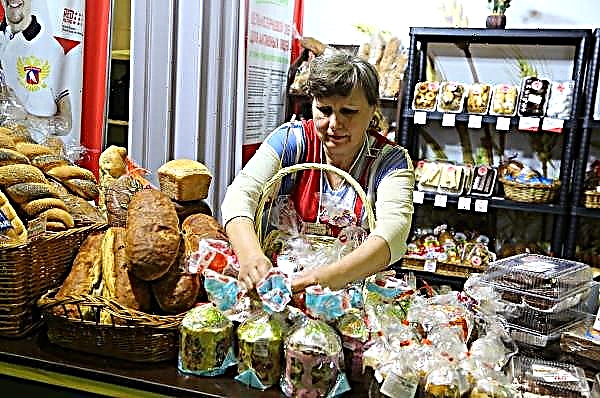The greenhouse on the plot opens up a lot of advantages. Not too expensive option is to build a structure from plastic pipes. How to construct a homemade greenhouse of a similar model, read below.
Features of the material for the manufacture
Pipes made of metal-plastic are gaining more and more popularity among users who are in search of inexpensive, high-quality materials for the manufacture of greenhouses. Like any other materials, pipes have pluses and minuses that need to be adequately evaluated in order to optimize work on the site.

Advantages and disadvantages
- The main advantages of plastic pipes:
- resistance to corrosion processes - unlike metal, plastic does not rust under the influence of moisture, maintaining its original appearance;
- light weight - the pipes are lightweight and durable, which is convenient in design and increases the mobility of the greenhouse if it needs to be moved from one part of the site;
- flexibility - the material has sufficient flexibility and is easy to cut, allowing you to create simple and complex joints, giving the frame any shape without the use of special equipment;
- fire resistance - the material ignites after a fairly long time after direct contact with an open source of fire and immediately stops burning after it is removed;
- long term of operation - the service life of such a design can be 50 years;
- easy operation - to create a design does not need special tools and additional processing of the material itself in the form of staining or impregnation with an antiseptic.
Did you know? The first creator of this winter garden, built in the 13th century, Albert Mangus, was accused of black magic and burned at the stake, because people simply did not believe that you can grow plants in winter without using witchcraft.
- Cons of materials:
- reduction in ductility at low temperature;
- the release of chlorine compounds during combustion;
- ease of construction - you need to take care of securing the building so that it does not roll over from a gust of wind.
Varieties of greenhouses made of plastic pipes
Depending on the shape, size and purpose of the greenhouse, plastic pipes can be made in several versions:
Also, designs are distinguished by season:
- summer;
- year-round.
How to make a greenhouse from plastic pipes with your own hands
Before making the frame, the first thing you need to do is choose a place on the site and calculate how many materials are needed. In addition, you should prepare the appropriate equipment for work in advance and calculate the dimensions of the structure.
Did you know? Ordinary people are allowed to visit the Royal Greenhouse in Belgium only once a year, at the height of the flowering of most plant specimens collected in it.
Step-by-step instructions for creating a greenhouse
You will need a detailed diagram with accurate calculations. For users who are doing this kind of work for the first time, it’s better to first do a small trial layout of cardboard.
Size calculation based on the type of greenhouse to create a drawing
For users who do not have experience in drafting, step-by-step instructions and ready-made drawings will help in this matter. The simplest structure is an arched greenhouse made of flexible pipes. When drawing up a drawing, it is imperative to consider where the doors and windows are.  These openings will play the role of a ventilation system that will help control air humidity and room temperature. The size of the greenhouse is completely dependent on the dimensions of the plot and the number of plants to be planted.
These openings will play the role of a ventilation system that will help control air humidity and room temperature. The size of the greenhouse is completely dependent on the dimensions of the plot and the number of plants to be planted.
To build a drawing of a simple arch-type greenhouse, use the formula L = 2πR, wherein:
- L is the length of the arc;
- π - unchanged, equal to 3.14;
- R is the radius of the circle.
For example, you want to get a greenhouse that is tall, that is, a circle radius of 2 m, 4 m wide. Then you get the following calculation: L = 2 × 3.14 × 2 = 12.56 m will be the full circumference of the greenhouse. But to calculate the length of one arc, you need to take only half of the resulting number, respectively, 12.56: 2 = 6.28 m.
Did you know? The inhabitants of the northern countries equip greenhouses close to their homes. This allows not only to facilitate the work of caring for plants, but also to additionally warm your own home.
Given that each arc will be double, i.e. made of 2 pipes, the resulting number must be divided again in half: 6.28: 2 = 3.14 m - the length of one pipe. A step of 1 m should be left between the arcs. From this it turns out that for the construction of an arched greenhouse 5 m long, 10 pipes of 3.2 m long are needed.

A variant of a gable greenhouse is usually performed in standard sizes:
- width - 4 m;
- length - 6 m;
- height from floor to roof - 2.5 m;
- height from the floor to the lower end of the ramp - 1.5 m.
The ramp is constructed at an angle of 25–35 °. On the roof, several air vents are necessarily provided, in the front of the building - a doorway, in the back - an insulated vestibule or the installation of a blank wall.
The framework basis will consist of:
- 12 pipes 1.5 m long and 10 pipes 1 m long - for walls;
- 12 pipes of 2 m - for the roof;
- 5 pipes of 1 m long - for the ridge.
Choosing and preparing a place for a greenhouse
The place for the greenhouse should be well lit by the sun and be protected from the northern cold winds. It is advisable that a row of tall trees be planted on the north side of the site. Otherwise, it is better to make the northern wall blank or to build a warmed vestibule. The site should be flat or with a slight slope to the south. It is also necessary to provide for the possibility of unhindered supply of water, light.

The soil in the greenhouse needs to be warmed up. To do this, remove the top 40 cm of soil and place liquid mullein or any other manure in their place in combination with compost. In the process of decay, heat and useful trace elements will be released. For each m² 10 kg of manure and the same amount of compost are added. After that, the soil is returned to its former place and wait 2-3 weeks until it settles. Then level the plot using the level.
Material selection and tool selection
For the construction of the greenhouse you will need to prepare the following materials:
- armature;
- wooden piles for the frame;
- foam blocks or brick;
- concrete;
- loops;
- door leaf;
- polycarbonate or reinforced film;
- plastic pipes for a major autonomous construction or HDPE for a small arch (they are more flexible).
Did you know? The largest greenhouse in the world is in the UK. It contains more than 1000 different exotic plants.
Of the tools required:
- self-tapping screws, thermowells, nails;
- punched tape, end and corner profiles;
- crosses;
- tees;
- screwdriver;
- plastic clamps;
- hammer;
- hacksaw;
- clerical knife;
- level;
- roulette;
- staples made of steel;
- clamps;
- welding machine for PVC;
- furniture stapler.
We make the base for the frame
It is best to install a greenhouse on a foundation. If this is a capital structure of a year-round type, then you need to take care of its construction 2 months before the installation of the structure. A simple structure can be installed on concrete blocks or bricks. To build the foundation, you need to make a markup of the site. The optimum dimensions of the strip foundation for the types of construction described above are 30 × 30 cm. The only difference is that for a year-round greenhouse it is better to pour the foundation with concrete.

In any case, you need to start by installing the wraps and pulling the twine between them. Next, you need to dig a trench with a depth of 30 to 50 cm, depending on the dimensions of the building and the type of soil. The bottom of the trench should be filled with a layer of sand - 5-10 cm, then with a layer of crushed stone - 5 cm. Next, bricks or foam blocks are installed, if the design is simple. A wooden frame is installed on the foam blocks.
To fix it at the corners, reinforcement sections are driven in 50 cm high, deepening them so that the protruding part ends strictly at the height of the wooden frame. Next, to fix plastic pipes on both sides, place pieces of reinforcement 70 cm long. They need to be deepened so that 40 cm protrudes above the wooden frame. The distance between the reinforcers for fixing the pipes is 1 m.
In the case of pouring concrete, you must first install the formwork, then reinforce in 2 layers and pour the cement mortar. After leveling, the concrete should be sprinkled with dry cement and lay the film on top. After 2 weeks, the formwork can be removed. The foundation will be ready for use after 4 weeks. When the foundation is ready, in the same way as in the previous version, you need to install mounting rebar around the entire perimeter of the proposed walls at a distance of 1 m from each other. Then lay the wood frame.
How to make a frame
Making a frame from pipes is not too difficult. More time is spent on preparing the site and the foundation than on its assembly.
From plastic pipes
Step-by-step instruction on the design of a gable greenhouse frame:
- On the supporting iron rods, put pipes with a height of 1.5 m, at the base, attach them with a stapler to the wooden frame.
- Fasten to the top of the strut posts.
- In the lateral holes of the crosses, fix the meter pipes in a horizontal position.
- Make a skate by connecting 5 pipes of 1 m with crosses among themselves.
- Build the ramps and connect them to the ridge. To do this, insert the pipes for the ramp into the upper holes of the crosses of the side slats with one end, and connect the other with the lower holes of the crosses of the ridge.

Passing to the final stage of work, it is necessary to strengthen the design with stiffening ribs.
For this:
- Weld pipes 1 m long between uprights.
- Weld stiffeners to the end parts of the frame at a height of 1.5 m.
- In the end parts of the building, construct openings for doors and windows. In the front of the building, put the pipes on pre-driven metal rods and fasten them with brackets to the wooden base.
- At the level of the wooden base, weld a meter pipe between the support posts. Weld the same pipe at the top of the posts. This will create a rectangular doorway.
- In the back of the building at a convenient height, construct an opening for the window in the same way.
- Build rectangular frames suitable for the size of the door and window leaf.
Did you know? In the 16th century, greenhouses became popular in Europe, which were called "houses of oranges." Their main purpose was the cultivation of exotic plants, including potatoes, which at that time were cultivated as a strange overseas flower.
From HDPE pipes
Step-by-step instruction on the design of an arched greenhouse:
- Connect 2 pipes of 3.2 m in one arc using crosses. There will be 4 semicircles in total.
- Connect the pairs with tees - these will be the end plates.
- Fix the arcs on metal rods - put one end of the pipe on the rod, fix the base to the wooden frame with a stapler, do the same with the second end of each of the arcs.
- Build openings for windows and doors according to the above principle.
We cover the frame with polyethylene or polycarbonate
The process of suturing the frame with a film and polycarbonate will be different. Consider both options and choose one that suits you.

Instructions for sewing a frame with a reinforced film:
- Cover the entire structure with a polyethylene cloth so that it hangs on all sides to the same length.
- Using wooden planks, fix the film on the outside of the wood base. Nail the boards from the center to the edge.
- After fixing one side, go to the other, pulling the film well.
- Lastly, fix the film on the end parts of the building, the doors and the window.
- Additionally, fix the film on the uprights using stationery clips.
- Hang the door and window leaf on the butterfly hinges.
Important! It is necessary to carry out tight-fitting work with a reinforced film at a temperature of at least + 16 ° C. Otherwise, it will sag.
Briefing on suturing the frame with polycarbonate:
- A day before the start of work, place polycarbonate in a dry room where the temperature is maintained at + 20 ° C.
- Take measurements of each aperture and cut polycarbonate panels with an office knife in accordance with them.
- Close the ends of the cut panels with punched tape and end profiles.
- Mount the roof. Having laid a sheet of a suitable size in the aperture, fix it with self-tapping screws and thermal washers, positioning them at a distance of 4 cm. Joint to joint, attach the second panel and fasten with the first accessory strips. Fasten the second sheet to the pipes.
- According to the above principle, install all panels, additionally reinforcing the corner seams with a special profile.
- In the lower part of the building, be sure to fix the sheets to a wooden base.
- Sew the door and window leaf. Hang them on butterfly loops.

Useful Material Selection Tips
Some useful tips on choosing material and making greenhouses:
- Starting the construction of the greenhouse, decide on its functional purpose - knowing what will be grown in the greenhouse, you can calculate the size and choose the right material.
- When choosing polycarbonate for sewing the frame, take sheets with a thickness of at least 4-6 mm. Thinner profiles will not cope with pressure.
- Instead of polyethylene, you can use an acrylic film. It differs in higher durability and long service life.
- For the construction of a polycarbonate greenhouse, use pipes with a diameter of at least 32 mm. The larger the pipe diameter, the less structural stability.
- Plastic pipes reinforced with fiberglass or aluminum are characterized by higher strength and a lower threshold for thermal expansion.
- Plastic pipes should not be bent during operation.
Greenhouses from plastic pipes of even the most complex model can be built in a couple of days. The main thing is to choose the right material and make the necessary miscalculations.Important! Polycarbonate absorbs moisture and swells, so the material should be stored only in dry rooms.












